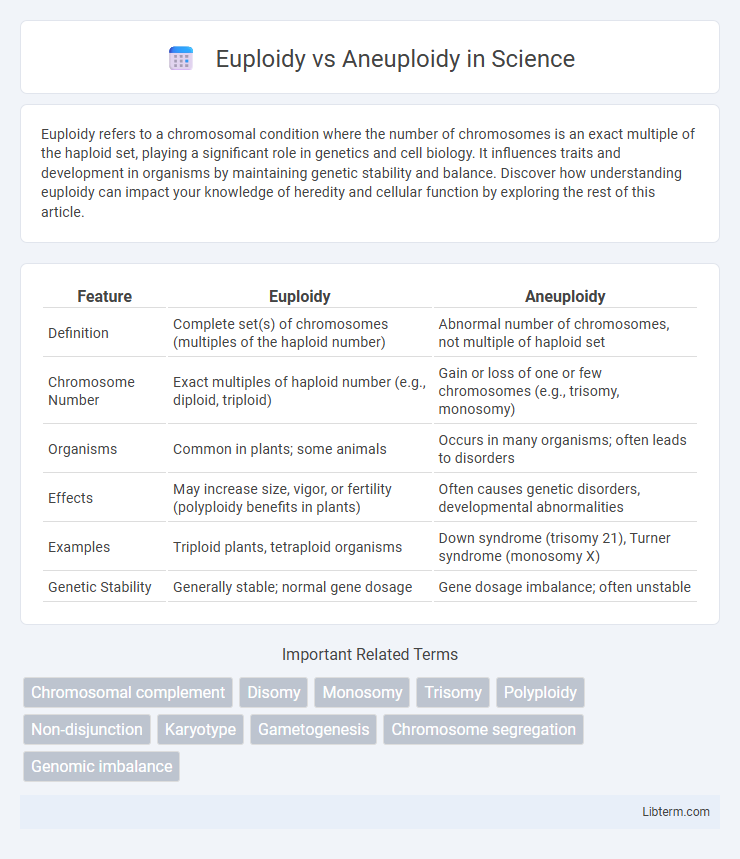Euploidy refers to a chromosomal condition where the number of chromosomes is an exact multiple of the haploid set, playing a significant role in genetics and cell biology. It influences traits and development in organisms by maintaining genetic stability and balance. Discover how understanding euploidy can impact your knowledge of heredity and cellular function by exploring the rest of this article.
Table of Comparison
| Feature | Euploidy | Aneuploidy |
|---|---|---|
| Definition | Complete set(s) of chromosomes (multiples of the haploid number) | Abnormal number of chromosomes, not multiple of haploid set |
| Chromosome Number | Exact multiples of haploid number (e.g., diploid, triploid) | Gain or loss of one or few chromosomes (e.g., trisomy, monosomy) |
| Organisms | Common in plants; some animals | Occurs in many organisms; often leads to disorders |
| Effects | May increase size, vigor, or fertility (polyploidy benefits in plants) | Often causes genetic disorders, developmental abnormalities |
| Examples | Triploid plants, tetraploid organisms | Down syndrome (trisomy 21), Turner syndrome (monosomy X) |
| Genetic Stability | Generally stable; normal gene dosage | Gene dosage imbalance; often unstable |
Introduction to Euploidy and Aneuploidy
Euploidy refers to the condition of having one or more complete sets of chromosomes, such as diploidy (two sets) or triploidy (three sets), which is essential for normal growth and development in many organisms. Aneuploidy involves the presence of an abnormal number of chromosomes, often resulting from nondisjunction during cell division, leading to conditions like Down syndrome (trisomy 21) or Turner syndrome (monosomy X). Understanding the distinctions between euploidy and aneuploidy is crucial for genetic research, cytogenetics, and clinical diagnostics related to chromosomal abnormalities.
Defining Euploidy: Concept and Types
Euploidy refers to the presence of a complete set of chromosomes in a cell, typically in multiples of the haploid number, such as diploidy (two sets) or triploidy (three sets). This chromosomal condition contrasts with aneuploidy, where cells contain an abnormal number of chromosomes that is not a complete set, leading to genetic imbalances. Euploidy plays a crucial role in normal growth and development, with its types influencing species variation and evolutionary processes.
Understanding Aneuploidy: Key Characteristics
Aneuploidy refers to the presence of an abnormal number of chromosomes in a cell, which disrupts the typical diploid set found in euploid organisms. This chromosomal imbalance often results from nondisjunction during cell division and can lead to developmental abnormalities and genetic disorders such as Down syndrome, characterized by an extra chromosome 21. Unlike euploidy, where whole sets of chromosomes are duplicated or lost, aneuploidy involves gains or losses of single chromosomes, significantly impacting gene dosage and cellular function.
Genetic Basis of Euploidy
Euploidy refers to the condition of having one or more complete sets of chromosomes, resulting from errors in meiosis or mitosis that lead to whole-genome duplications. The genetic basis of euploidy involves the accurate replication and segregation of entire chromosome sets, maintaining genomic stability and normal gene dosage. Unlike aneuploidy, which involves the gain or loss of individual chromosomes, euploidy preserves balanced chromosomal complements essential for normal development and cellular function.
Chromosomal Causes of Aneuploidy
Euploidy refers to the condition of having one or more complete sets of chromosomes, which is normal in most organisms, while aneuploidy involves an abnormal number of chromosomes, typically due to errors in chromosome segregation during cell division. Chromosomal causes of aneuploidy primarily include nondisjunction events during meiosis I or II, resulting in gametes with missing or extra chromosomes. Structural chromosomal abnormalities such as deletions, duplications, or translocations can also contribute to aneuploid conditions by disrupting normal chromosome pairing and segregation.
Impact on Organism Development
Euploidy involves the presence of one or more complete sets of chromosomes, often leading to normal development or increased variation in plants and some animals, facilitating speciation and adaptability. Aneuploidy, characterized by an abnormal number of individual chromosomes, typically disrupts gene dosage balance, frequently resulting in developmental disorders, congenital anomalies, or lethality in organisms. The impact on development varies significantly; euploidy tends to maintain genomic stability and viability, whereas aneuploidy commonly causes detrimental phenotypic consequences such as Down syndrome or Turner syndrome.
Examples of Euploidy in Nature
Euploidy refers to organisms having one or more complete sets of chromosomes, commonly seen in plants like wheat (Triticum aestivum) with hexaploid genomes and bananas (Musa spp.) exhibiting triploidy. Euploidy contributes to genetic diversity, adaptation, and speciation by providing balanced chromosome sets, contrasting aneuploidy, which involves irregular chromosome numbers causing developmental disorders. Examples of euploidy highlight evolutionary advantages in agriculture, such as improved crop yield and stress resistance.
Clinical Significance of Aneuploidy
Aneuploidy, characterized by an abnormal number of chromosomes, is clinically significant due to its association with various genetic disorders and congenital anomalies, such as Down syndrome (trisomy 21), Turner syndrome (monosomy X), and Edwards syndrome (trisomy 18). It often leads to developmental delays, intellectual disabilities, and increased risk of miscarriage or infertility. Early detection through prenatal screening and diagnostic techniques plays a crucial role in managing pregnancy outcomes and providing genetic counseling.
Diagnostic Methods for Chromosomal Abnormalities
Diagnostic methods for chromosomal abnormalities differentiate Euploidy and Aneuploidy through techniques such as karyotyping, fluorescence in situ hybridization (FISH), and comparative genomic hybridization (CGH). Karyotyping enables visualization of whole chromosome sets to detect numerical changes, identifying euploid cells with uniform chromosome numbers and aneuploid cells with missing or extra chromosomes. FISH and CGH provide higher resolution and sensitivity for detecting specific aneuploid regions, facilitating early and accurate diagnosis in prenatal and cancer genomics contexts.
Future Perspectives in Chromosomal Research
Advancements in genome editing technologies like CRISPR-Cas9 promise precise correction of euploidy and aneuploidy-associated chromosomal abnormalities, offering potential therapeutic solutions for genetic disorders. Integration of high-resolution single-cell sequencing and AI-driven data analysis is expected to enhance early detection and classification of chromosomal anomalies, improving prognostic accuracy. Emerging research in epigenetics and chromosomal architecture will likely illuminate mechanisms driving aneuploidy, guiding the development of targeted interventions to restore chromosomal stability.
Euploidy Infographic

 libterm.com
libterm.com